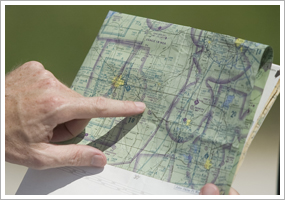| The following stories from the July 9, 2010, edition of AOPA ePilot were provided to AOPA members who expressed an interest in the particular subject areas. Any AOPA member can receive information tailored to their areas of interest by updating their preferences online. |
training tips‘Bracketing’ the course
Obstacle clearance should now be reviewed. Winds aloft will likely be from a different direction, at a different speed. Those changes follow certain rules of thumb, but not always, so make an estimate as soon as possible. Calculate your new groundspeed and fuel requirements. Also, if you had planned to overfly any airspace controlled to the surface, ensure that you will not penetrate it. That possibility does not necessarily require a course change. Frequently, a call to the Class D control tower or Class C approach control facility will win you permission to proceed through the area. Student pilots must adhere to special rules governing operations in Class B airspace. Review airspace in the AOPA Air Safety Foundation’s interactive course Know Before You Go .
If you picked quality visual checkpoints, you won’t need to change them now in the cramped cockpit. You’ll have made things easier for yourself if you selected checkpoints designed to “bracket” your course, as explained in Chapter 15 of the Pilot’s Handbook of Aeronautical Knowledge : “The checkpoints selected should be prominent features common to the area of the flight. Choose checkpoints that can be readily identified by other features such as roads, rivers, railroad tracks, lakes, and power lines. If possible, select features that make useful boundaries or brackets on each side of the course, such as highways, rivers, railroads, and mountains. A pilot can keep from drifting too far off course by referring to and not crossing the selected brackets. Never place complete reliance on any single checkpoint.”
The most important tip is to act promptly once you decide to make a change. Then evaluate the situation again, keeping open all options you considered during planning for concluding the flight in the safest possible manner. training productsSquare Chart PlotterNew from ASA is a square plotter that is guaranteed for life against warping, breaking, or melting. The $6.95 plotter features 5-nautical-mile and 10-nm rings, and allows for quick and easy flight planning. Note: Products listed have not been evaluated by ePilot editors unless otherwise noted. AOPA assumes no responsibility for products or services listed or for claims or actions by manufacturers or vendors. final examQuestion: Yesterday my instructor mentioned something about a DF steer. Can you explain to me what that is?
Answer: DF stands for direction finder and is a good resource to use if you become lost. Here’s how it works. Once you realize you are lost, contact the nearest flight service station, apprise them of the situation, and ask if they have the capability to provide a DF steer. If they do, the specialist at the flight service station will have you depress your microphone button for a specified length of time. Using special equipment, the specialist can home in on your transmission to determine your bearing from the facility. They can then use that information to give you a heading to the airport. The benefit of this system is that it works in areas or altitudes not covered by radar. For more on the topic read the article “ Lost and Unhappy” on the Flight Training website.
Got a question for our technical services staff? E-mail [email protected] or call the Pilot Information Center, 800/872-2672. Don’t forget the online archive of “Final Exam” questions and answers, searchable by keyword or topic. |
 You’re on a solo cross-country flight when conditions aloft make you decide to switch to Plan B. The weather is not bad enough to make you turn around, but it would be helpful to have better forward visibility (see the June 25 “
You’re on a solo cross-country flight when conditions aloft make you decide to switch to Plan B. The weather is not bad enough to make you turn around, but it would be helpful to have better forward visibility (see the June 25 “ 